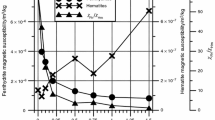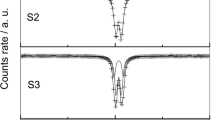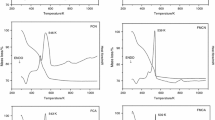Abstract
Well-crystallized ferrihydrite as indicated by its X-ray powder diffraction pattern and low solubility in acidified oxalate (Feo/Fet = 0.27) was formed by the oxidation of FeCl2 solution containing Si/Fe = 18 × 10−3. The crystallinity of ferrihydrites formed from the solutions containing Si/Fe > 18 × 10−3 was lowered as indicated by weaker and broader XRD lines and increased oxalate solubility. Ferrihydrites formed in the presence of silica did not give the differential thermal analysis exothermic peak between 350° and 450°C that is found for ferrihydrites prepared from the hydrolysis of Fe(III) salts. The transformation of ferrihydrite (formed at Si/Fe = 18 × 10−3) to hematite was inhibited by the presence of 1.48% SiO2 in the oxidation products.
Резюме
Хорошо кристаллизированный железогидрит формировался путем окисления раствора FeCl2, содержащего Si/Fe = 18 × 10−3, что показано при помощи рентгеновских порошковых дифракто-грамм (РПД) и низкой растворяемости в подкисленном оксалате (Feo/Fet = 0,27). Кристалличность железогидритов, формированных из растворов с Si/Fe = 18 × 10−3 уменьшалась, что показано при помощи более слабых и широких линий РПД и увеличивающейся растворяемости в оксалате. Же-лезогидриты, формированные в присутствии кремнезема, не давали экзотермических пиков между 350° и 450°С (по дифференциальному термическому анализу), которые находились в случае железогидритов, подготовленных путем гидролиза соли Fe(III). Трансформация железогвдрита (образованного при Si/Fe = 18 × 10−3) в гематит задерживалась при присутствии 1,48% кремнезема в продуктах окисления. [E.G.]
Resümee
Gut kristallisierter Ferrihydrit, wie durch seine Röntgenpulverdiagramme und seine niedrige Löslichkeit in angesäuerter Oxalatlösung angezeigt wird (Feo/Fet = 0,27), wurde durch die Oxidation von FeCl2-Lösungen, die ein Si/Fe-Verhältnis von 18 × 10−3 aufwiesen, hergestellt. Die Kristallinität von Ferrihydriten, die aus Lösungen mit Si/Fe > 18 × 10−3 gebildet wurden, wurde verringert, wie durch schwächere und breitere Röntgendiffraktometerpeaks und gestiegene Löslichkeit in Oxalatlösung hervorgeht. Ferrihydrite, die sich in Gegenwart von SiO2 bildeten, ergaben bei der Differentialthermoanalyse keinen exothermen Peak zwischen 350° und 450°C, den man bei Ferrihydriten findet, die durch Hydrolyse von Fe(III)-Salzen hergestellt wurden. Die Umwandlung von Ferrihydrit (gebildet bei Si/Fe = 18 × 10−3) in Haematit wurde durch die Anwesenheit von 1,48% SiO2 in den Oxidationsprodukten verhindert. [U.W.]
Résumé
La ferrihydrite bien cristallisée, indiqué par son cliché de diffraction aux rayons-X et par sa basse solubilité dans l’oxalate acidifiée (Feo/Fet = 0,27) a été formée par l’oxidation d’une solution FeCl2 contenant Si/Fe =18 × 10−3. La cristallinité de ferrihydrites formées de solutions contenant Si/Fe > 18 × 10−3 était plus basse comme l’ont indiqué des lignes XRD plus faibles et plus larges, et une plus grande solubilité dans l’oxalate. Les ferrihydrites formées en présence de silice n’ont pas donné le sommet exothermique d’analyse thermique differentielle entre 350° et 450°C que l’on trouve pour les ferrihydrites préparées à partir de l’hydrolyse de sels Fe(III). La transformation de ferrihydrite (formée à Si/Fe = 18 × 10−3) en hématite a été inhibée par la présence de 1,48% SiO2 dans les produits ďoxidation. [D.J.]
Similar content being viewed by others
References
Boltz, D. F. and Mellon, M. G. (1947) Determination of P, Ge, Si and As by the heteropoly blue method: Anal. Chem. 19, 873–878.
Carlson, L. and Schwertmann, U. (1981) Natural ferrihydrites in surface deposits from Finland and their association with silica: Geochim. Cosmochim. Acta 45, 421–429.
Chukhrov, F. V., Zvyagin V. V., Ermilova L. P., and Gorsh-kov, A. I. (1973) New data on iron oxides in the weathering zone: Proc. Int. Clay Conf., Madrid, 1972, J. M. Serratosa, ed., Div. Ciencias C.S.I.C, Madrid, 333–341.
Henmi, T., Wells, N.. Childs, S. W., and Parfitt, R. L. (1980) Poorly ordered iron-rich precipitates from springs and streams on andesitic volcanoes: Geochim. Cosmochim. Acta 44, 365–372.
Iwasa, Y. (1965) Mineralogical studies of iron minerals in soils: Bull. Nat. Inst. Agric. Sci. (Japan), Ser. B15, 187–244.
Jackson, T. A. and Keller, W. D. (1970) A comparative study of the role of lichens and ‘inorganic’ processes in the chemical weathering of recent Hawaiian lava flows: Amer. J. Sci. 269, 444–466.
Karim, Z. (1977) The control of iron hydrous oxides crystallization by traces of inorganic components in soil solution: Ph.D. Thesis, University of Reading, 100–116.
Karim, Z., Rahman, M. A., and Rahman, S. (1981) Mineralogy of acidic tea soils and sorption of phosphate. Tea Quarterly 50, 175–182.
Schwertmann, U. (1964) Differenzierung der Eisenoxide des Bodens durch Extraktion mit Ammonium-oxalat-Lösung: Z. Pfl. Ernahr. Düng. Bodenk. 105, 194–202.
Schwertmann, U. and Fischer, W. R. (1973) Natural ‘amorphous’ ferric hydroxide: Geoderma 10, 237–247.
Schwertmann, U. and Thalmann, H. (1976) The influence of [Fe(II)], [Si] and pH on the formation of lepidocrocite and ferrihydrite during oxidation of aqueous FeCl2 solutions: Clay Minerals 11, 189–199.
Schwertmann, U., Schulze, D. G., and Murad, E. (1982) Identification of ferrihydrite in soils by dissolution kinetics, differential X-ray diffraction and Mössbauer spectroscopy: Soil Sci. Soc. Amer. J. 46, 869–875.
Taylor, R. M. (1959) Amorphous iron oxides in soils: J. Soil Sci. 10, 309–315.
Towe, K. M. and Bradley, W. F. (1967) Mineralogical constitution of colloidal hydrous ferric oxides: J. Coll. Interface Sci. 24, 384–392.
Author information
Authors and Affiliations
Rights and permissions
About this article
Cite this article
Karim, Z. Characteristics of Ferrihydrites Formed by Oxidation of FeCl2 Solutions Containing Different Amounts of Silica. Clays Clay Miner. 32, 181–184 (1984). https://doi.org/10.1346/CCMN.1984.0320304
Received:
Accepted:
Published:
Issue Date:
DOI: https://doi.org/10.1346/CCMN.1984.0320304




